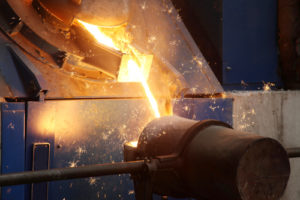When zinc coating is electroplated onto iron-containing ferrous metals’ surface, it creates a corrosion-resistant barrier, while giving a number of other advantages.
Zinc has the ability to develop corrosion byproducts, which can considerably reduce ferrous metals’ corrosion rate. Zinc patina serves as a protective barrier on the surface of the ferrous metals. They help in keeping out moisture, which can considerably speed up the process of corrosion. Depending upon environmental conditions, it can corrode at a maximum rate of hundred times slower than other metals.
Zinc coating on the metals forms the protective barrier against moisture. The process that forms it on them is called zinc plating. The process can differ depending upon the metal finishing company’s preferences, and the zinc plating application available. Generally, it starts by cleaning the metal’s surface using an alkaline detergent solution in order to get rid of oil, debris or other materials. The metal part is then treated using an acidic solution in order to get rid of rust or surface scales.
After the cleaning phase, the main process can start. The part is immersed in electrolyte solution that contains dissolved zinc. An electric current (DC) is then introduced into it, which then deposits zinc onto the cathode – the less-chemically active item, or the component being plated. It is referred to as electrodeposition. Zinc serves the anode’s role.
A potential problem with plating zinc is that it is likely the metal will come in contact with hydrogen molecules, during the process. It can result in hydrogen embrittlement, a condition where it causes metal to weaken and can even lead to cracking. However, by baking the part after plating, the hydrogen through it can be diffused, which helps minimize embrittlement risk.
Types of Zinc Plating
The zinc plating types can be recognized by the color made by different formulations. Every color gives different levels of protection against corrosion.
Yellow Zinc
This zinc coating type is used commonly in the automotive segment and provides an average level of protection.
Black Zinc
The black coatings are available as black oxide, which can really be olive-drab colored, or pure black coating. Usually, the former will offer slightly better resistance to corrosion.
Clear Zinc or Blue Zinc
This zinc coating formulation tends to give fewer amounts of protection against corrosion, even though it is considered more environmentally friendly.
Acid Zinc
It varies from other zinc plating types since it does not introduce cyanide to the plating bath. Acid zinc’s key benefit is that it can be effective for use on substrates that are tough to plate.
Other Important Benefits of Zinc Plating

Benefits Of Zinc Plating
When considering it, corrosion protection is not the only potential benefit of zinc plating. Its other important advantages comprise the following.
- Low Cost – Zinc is more affordable and abundant than several other metals that are used for plating. Of course, when it comes to a cost-effective plating option, zinc makes for a fine alternative.
- Bright Finish – Sometimes, plating is used to enhance a metal surface’s appearance. This is often done to make the metal part more attractive to prospective customers. Zinc plating can offer a brightness level that is a chromium equivalent. The levels of brightness can be controlled using a range of additives. Besides, an array of available colors offers a lot of flexibility for selecting the most suitable finish.
- A Wide Range of Surface Appearances – The coatings can be made in an array of patterns and textures. A plain and smooth surface or rough texture with spangled pattern can be achieved.
- Easy to Apply – It is easy to apply the coatings. The plating process results in a deposit that will not damage the substrate. Besides, zinc can be used with an array of plating bath chemistries.
- Zinc Can Be Used with Different Plating Methods – It can be used with rack plating and barrel plating. This means that the zinc plating can accommodate parts of different sizes as well as workload volumes.
- Works Well as Undercoats – In case your applications entail e-coating or painting, then zinc can be a very effective undercoat owing to its exceptional adhesive properties. Undoubtedly, it will also improve coated or painted surfaces’ corrosion resistance.
Limitations of Zinc Plating
As with any metal surface finishing, zinc plating have its own limitations. For example, zinc usually does not perform fine at high temperatures. The corrosion protection abilities of it start to reduce considerably when they reach as well as exceed 212 degrees Fahrenheit. Unless the parts subjected to the plating process are appropriately baked after it, embrittlement can happen when the temperature exceeds 500 degrees Fahrenheit.
Besides, distributing the coating evenly over the metal’s surface can be challenging. Objects confined in areas prone to moisture may promote quick corrosion of surfaces that are plated with zinc. It does not hold up well against acids or alkalis though, and an array of factors can affect the coating’s lifespan, comprising the thickness of it and the atmosphere composition.
